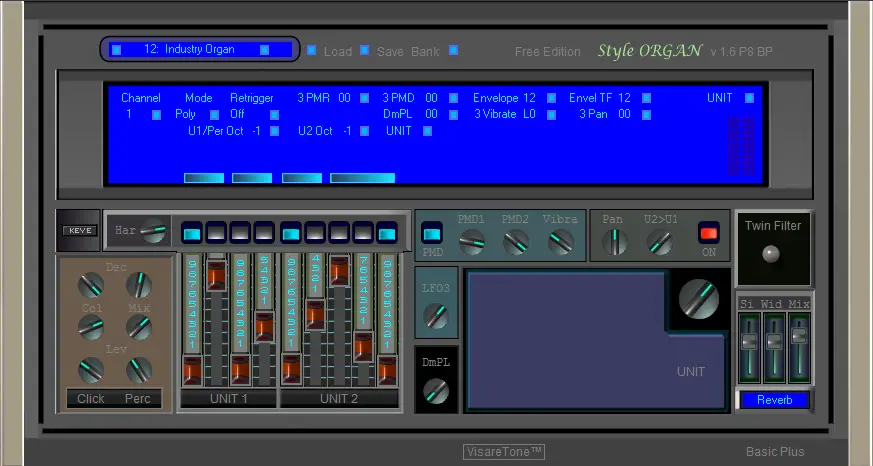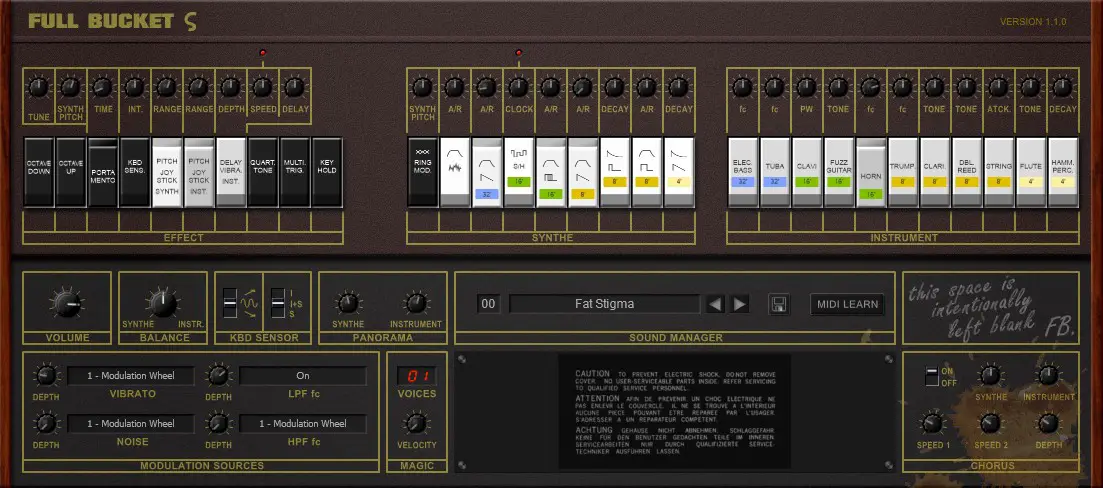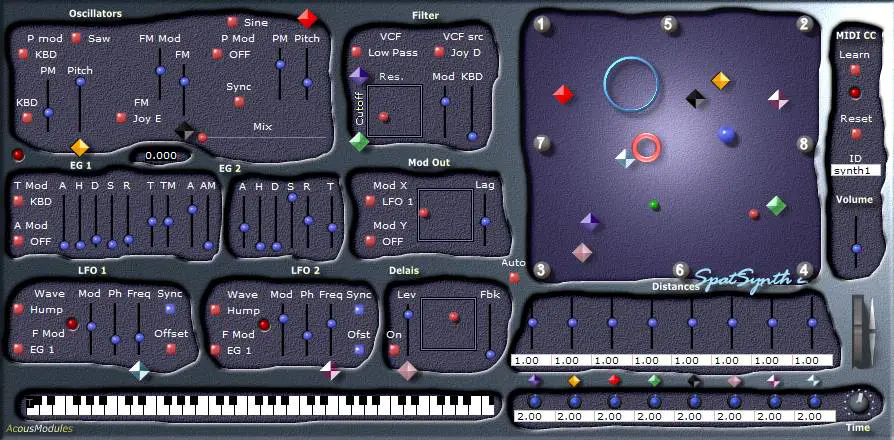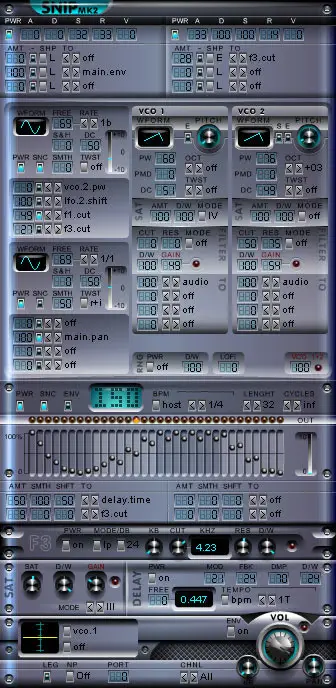[update beta5m August 6th 2019]
Public Beta, free to download, time limited at 15 minutes per session.
– VST2 64-bit for Windows* (and soon also VST2 for Mac).
– Brand new control for waveshape morphing.
– Extra sound engine for the paraphonic mode (“Paraphony” on GUI)
with new timbral characteristics, featuring “analogue pulsed noise” emulation.
– The paraphonic mode allows very different articulations
compared to the standard polyphonic mode (“Polyphony” on GUI).
– As per above, “Polyphony” vs “Paraphony” is now not just a change of behaviour
of the ADSR envelope.
– Redesigned filters for the voice stops, especially for the ones labeled “Brass” and “Horn”.
– Recalibrated relative gains of all the voice stops.
– “Ensemble” chorus DSP upgraded to higher order interpolation (improved transparency and warmth).
– Rewritten “Spring” algorithm for Reverb, to allow longer resonances.
– Reviewed all presets/patches.
– Analogue Drum Kit: bonus feature: 20 of the best LoFi sounds from Drum Machines* of the late Seventies.
(playable using the MIDI keys above the Strings sound range)
– Minor changes in the GUI and other minor bugs fixed. Larger GUI also available.
Three skins included. User can easily make custom skins by making PNG files.
– Everything that was already good in 1.x has been kept.
(Presets previously made for SDS 1.x needs to be adjusted when loaded in SDS 2.0)
*Formats: 32-bit VST2 will be delivered on customer request.
SDS AU for macOS will be produced after at least 100 requests.
*Drum Machines samples from NUSofting DK+ Library.
MIDI keys range: note 92 to 111. Volume controlled by MIDI Velocity.
[note: this is just a bonus feature for SDS, if you are interested in a true
Analogue Drum Set VST plugin to be release please let me know].
Sound ——–: Note Number
HiHat1——–: 92 [usually G#5 in pianoroll]
Snare1——–: 93
KickDrum1—–: 94
Rim1—– —-: 95
Clave1——–: 96
CowBell1——: 97
Cymbal1——-: 98
Guiro1——–: 99
Bongo1——–: 100
Bongo2——–: 101
Conga1——–: 102
Maracas1——: 103
HiHat2——–: 104
Snare2——–: 105
KickDrum1—–: 106
Cymbal2——-: 107
Tom1———-: 108
Tom2———-: 109
Tom3———-: 110
Tom4———-: 111.
Things you NEED to know to fully enjoy Strings Dream Synthesizer:
1) The ranges of the stops/registers, by checking the SDS help docs.
2) Cello and C.Bass voices are monophonic and can be played in legato
at the same time of the polyphonic main voices.
3) A hidden bonus feature is the 20 sounds Analogue Drum Kit, playable with the top range MIDI notes.
Strings Dream Synthesizer is able to reproduce the infinite array of rich, analogue pads from the most famous strings machines in synthesizer history – emulating the classic Eminent Solina as well as its sister keyboards from Elka, Crumar and even their Japanese cousins.
Strings Dream Synthesizer does not use samples. Instead the “octave divider” circuitry typical of those early polyphonic synths has been natively emulated, so that all sounds are computed in realtime in true VA fashion.
The fundamental “Ensemble” effect (like the vintage Solina chorus) accurately follows the architecture of its hardware counterpart, including the BBD chip behaviour for truly rich modulation. However, it has been extended for a wider range of “chorus” effects.
Strings Dream Synthesizer is easy to use. Its layout and features take their cue from and expand upon the familiar Solina design, with only the necessary controls to achieve the textures of the other strings machines.
Main Features:
- “True analogue sound”, VA “Octave Divider” emulation, (no samples used).
- 43 voices full polyphony, plus mono legato on bass section.
- Vintage audio effects on board.
- MIDI learn on every knob.
- 3 skins included.
Plus:
- A full ADSR envelope generator and Waveform selection (for several strings and organs sounds).
- Volume fader and switch for each of 6 stops (C.Bass, Cello, Brass, Horn, Viola and Violin). The fader for each stop allows an almost infinite number of mixtures.
- A powerful parameter to tune the relative phase of Violin wave against the other voices.
- Brightness and highpass filters are also adjustable.
- More performance flexibility with MIDI velocity and polyphonic mode selectable.
- Note also that the C.Bass and Cello are monophonic with full legato mode and you can select one of eight keyboard split points, allowing you to layer the mono voices with the others.
- Chorus “Ensemble” effect with “Bucket-brigade device” tone.
- Four-stage Phaser for those famous “Jarre pads” and other Tangerine Dream sounds.
- Exclusive reverb with the ability to morph on request to that “trembling” sound of the vintage spring reverb units.
http://nusofting.com/











